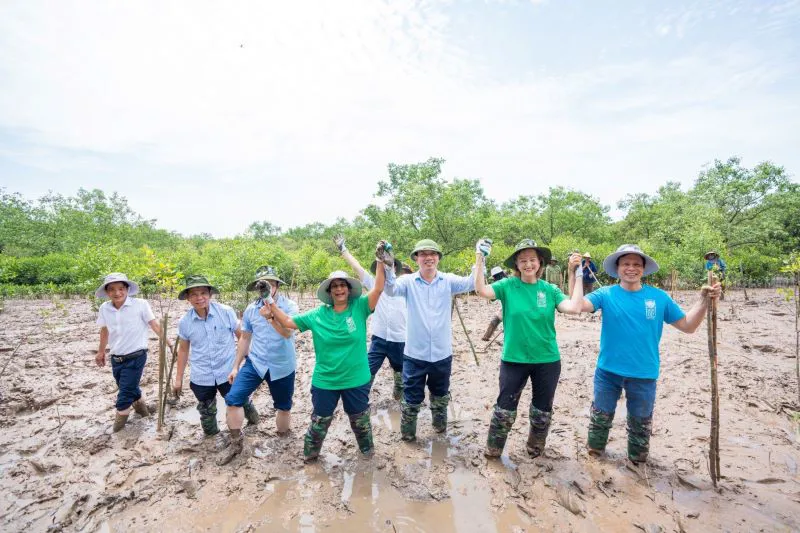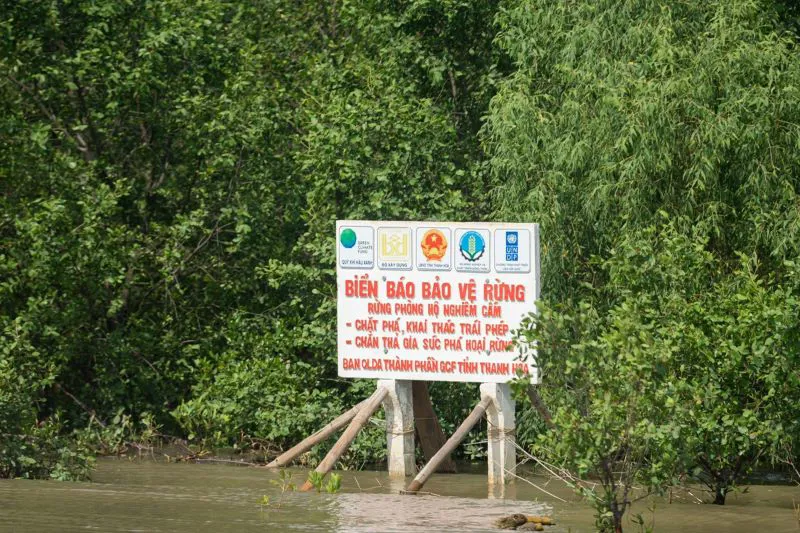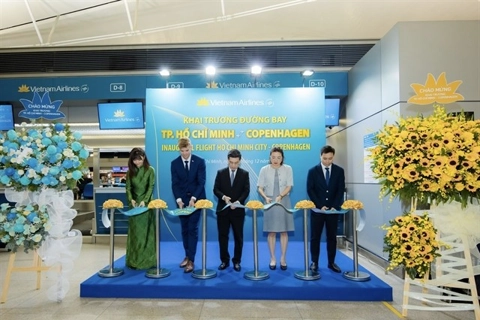UNDP intensifies mangrove afforestation in Vietnam
Mangroves and storm-resilient houses are proved to be the best choices against climate change for coastal areas in Vietnam in a five-year project starting in 2017, with support of UNDP and GCF.
The United Nations Development Fund (UNDP) has been expanding mangrove forests in coastal areas of Vietnam in a project to improve the resilience of vulnerable coastal communities to climate change.
Ta Thi Bieu (C) in Minh Loc Commune, Hau Loc District, Thanh Hoa, a beneficiary of the UNDP-supported resilient housing project. Photo: Bao Thanh Hoa |
Its latest activities took place in the central province of Thanh Hoa in a project for better livelihoods in Ba Thuoc District from July 2021 to June 2023.
Thanh Hoa is one of 28 coastal localities benefiting from the project that has grown 4,000 hectares of mangrove forests nationwide in a five-year span under the partnership with the Green Climate Fund (GCF). So far, more than 300 hectares of mangroves have been grown and more than 1,400 resilient houses built in the locality.
Since 2017, UNDP, GCF, and the Government of Vietnam have regenerated and planted more than 4,000 hectares of mangrove forests and approximately 4,000 resilient houses nationwide.
The progress to date has benefited nearly 46,000 people who have access to climate change and resilience information, far more than the targeted number of 20,000.
More than 8,000 people in Thanh Hoa alone have benefited from the project.
| UN Assistant Secretary-General and UNDP Regional Director for Asia and the Pacific Kanni Wignaraja (4th from right) and UNDP Resident Representative in Vietnam Caitlin Wiese (2nd right) and leaders of Thanh Hoa province in a local mangrove plantation on July 30. Photo: UNDP |
“Mangroves are among the most effective nature-based solutions,” said UNDP Resident Representative in Vietnam Caitlin Wiesen, who joined the mangrove plantation in Thanh Hoa last weekend.
According to Wiesen, they are a source of sustainable livelihoods such as aquaculture and beekeeping, while contributing to carbon sequestration and biodiversity conservation, protecting lives, livelihoods, and infrastructure, as well as increasing the forest coverage rate in Vietnam. “They help Vietnam to achieve its climate and development ambitions in a resilient and sustainable way,” she noted.
To identify safe locations for building resilient homes, the project has also conducted a series of community-based disaster risk management (CBDRM) activities, including risk assessments. To date, over 8,000 people (with over 50% women) have benefited from this training across the province, thus being able to assess the risks posed by disasters and climate change and develop location-specific disaster risk maps and risk reduction plans.
The resilient houses supported by the GCF-funded coastal resilience project have withstood a series of record-level floods and storms in 2020, said UN Assistant Secretary-General and UNDP Regional Director for Asia and the Pacific Kanni Wignaraja during the trip to the mangrove plantation in Thanh Hoa last weekend. She stressed the importance of mangrove forests and resilient houses in the locality as the efficacy has been proved over the past years. In reality, the demand for more climate- and disaster-resilient housing in the province is tremendous.
Le Duc Giang, Vice-Chairman of Thanh Hoa Provincial People’s Committee, expressed his gratitude for UNDP’s support in enhancing the resilience and livelihoods of local communities, expecting further cooperation to build more storm-resilient houses; regenerate mangrove forests in ways that engage local communities with livelihoods; as well as increase local knowledge in disaster risk management.
Meanwhile, Global Environment Facility-funded projects implemented by UNDP are promoting the sustainable use of the indigenous bamboo forest in Thanh Hoa. Experts said these projects serve as examples of a combination of local species with high economic values and an open market to give high economic results while protecting the environment.
| A mangrove plantation in Thanh Hoa. Photo: UNDP |
Mangroves become the best choice in climate response for coastlands in climate-hit areas like coastal provinces and the Mekong Delta as they can hold up to four to five times more carbon per hectare than tropical rainforests.
Dr. Pham Thu Thuy, Team Leader of Climate Change, Energy and Low-carbon Development, at the Center for International Forestry Research (CIFOR), pointed out three key fields that mangroves affect, namely aquaculture, biodiversity, and carbon credit market.
Obviously, mangroves provide nursery habitats for many species, contributing to sustaining the local abundance of fish and shellfish populations. Mangrove forests contribute to species richness, providing habitat for thousands of species at all levels of marine and forest food webs. The last but not least, mangroves play a crucial role in carbon absorption, which means that mangrove carbon credits have become more important in the global carbon market, the expert told The Hanoi Times.














